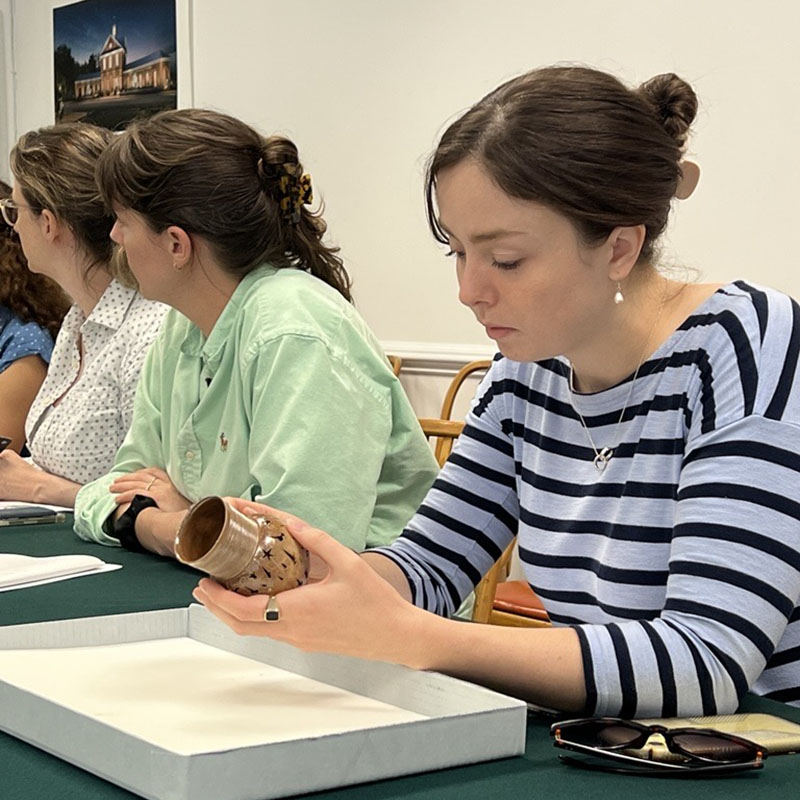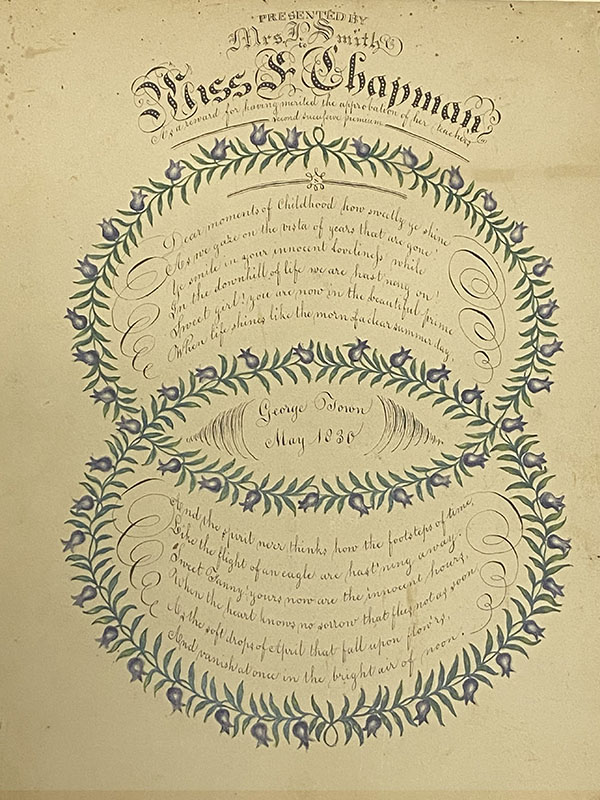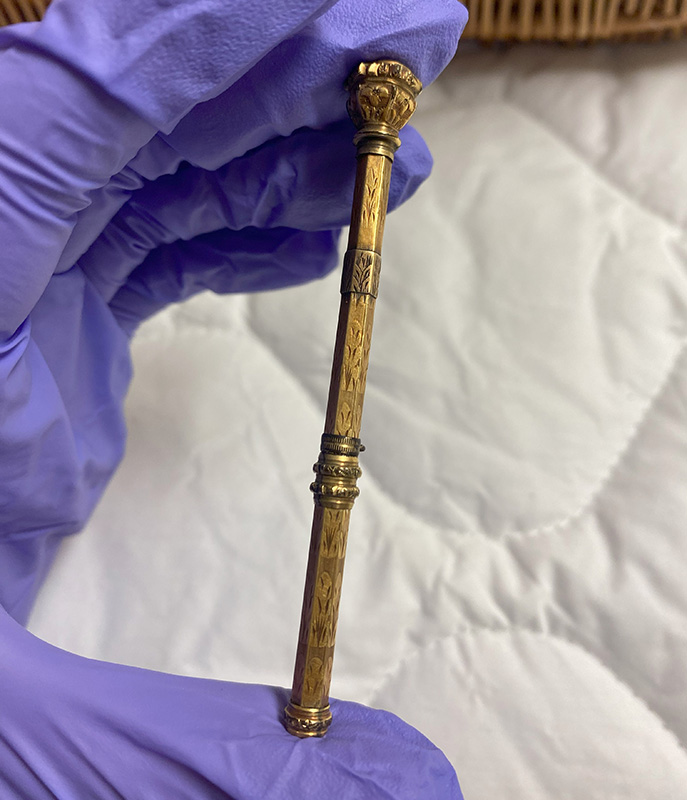Merit for the Student, Merit for the Teacher: The Multiple Meanings of 19th-century Decorated Awards
by Allison Donoghue
Through the generosity of the Decorative Arts Trust, I had the privilege of attending the Summer Institute at the Museum of Southern Decorative Arts (MESDA) as the William C. and Susan S. Mariner Fellow for Emerging Museum Professionals. At Summer Institute, I spent four weeks immersed in MESDA’s incredible decorative arts collections in Winston-Salem, NC, where I received in-depth object-based instruction in Southern decorative arts from experts in the field (figure 1). I also had the opportunity to learn about the entire making process by spending time with the experienced craftspeople who work at the Old Salem Museum and Gardens (figure 2). The curriculum focused primarily on the decorative arts of the Chesapeake and was complemented by a week-long trip through Virginia, Washington, D.C., and Maryland that allowed for up-close study of decorative arts collections and museums throughout the region.
As a part of the program, fellows completed intensive research on an item from MESDA’s collection and gave a presentation. I researched a merit award presented to Frances Isabella Chapman in 1830 (figure 3). The hand-decorated award celebrated her attendance at Mrs. Smith’s Day school in Georgetown, now a part of Washington, D.C. Her teacher, Mrs. Isabella Graham Smith, was the daughter of famed female educator and philanthropist Isabella Marshall Graham.
Frances Chapman was born in 1819 to a judge and prominent member of the community, Major Henry Henley Chapman, and Mary Davidson Chapman. The Champans lived at the northwest corner of Dumbarton Avenue and Congress Street in Georgetown. Like many girls of her social status, Frances received a finishing education which may have included reading, writing, and mathematics as well as needlework, penmanship, and painting or music.
The award Chapman received was entirely hand-decorated. The heading announced Frances’s name and her school, in large bold script that subtly framed intersecting circles of blue bells. Within the circles—written in perfect cursive—was a poem by James Gates Percival.1 The poem, extolling the sweetness and brevity of childhood, was paraphrased and tailored for Frances. Although Percival’s original verse lamented the author’s inability to return to those “innocent hours,” the award highlighted Frances’s current moment of childhood and was further personalized with the endearments of “Sweet Girl” and the use of her nickname, “Fanny.” The flowers themselves may have been chosen for their meaning: bluebells were associated with the idea of faithfulness in the 19th century. Completely unique, the award is the only extant example of a certificate of merit from Smith’s school. Possibly decorated by Mrs. Smith herself, or one of her daughters who assisted in teaching, the carefully hand-wrought designs demonstrated mastery of the refined skills Smith advertised to teach the young ladies that attended her school.
My research focused on how Smith used the award, along with the hundreds of advertisements she published in local papers, to display her skills. The demonstration of these skills through the award proved she was a capable teacher and ultimately may have helped her to establish her school.
Isabella Graham Smith came from a line of successful female teachers. Her mother, Isabella Marshall Graham, a famed teacher and philanthropist, published letters and opinions in New York newspapers and was a household name by the time she died in 1814. Her daughters, Joanna Graham Bethune and Isabella Graham Smith, both went into teaching. Isabella taught in her mother’s boarding school in New York City until it closed in 1797—the same year she married Andrew Smith. After her marriage, Smith continued teaching, operating a school out of her home at 9 Murray Street.
Smith moved to Georgetown in 1828 where she sought to establish a boarding school similar to those in New York. She used print advertisements to promote herself and her Female Academy. Between 1829–32, Smith published an impressive 354 advertisements in local newspapers. It was important for Smith to distinguish herself and her Female Academy from other girls’ schools in Georgetown and Washington City. The former already had several finishing schools for the wealthy inhabitants of the city when she arrived.
Even though hand-decorated personalized awards celebrated the academic achievements of students, they also demonstrated a teacher’s skill in painting, drawing, penmanship, and English. In Rewards of merit: tokens of a child’s progress and a teacher’s esteem as an enduring aspect of American religious and secular education (1994), Patricia Fenn argues that expertly creating and executing original designs was a professional skill for teachers. A handmade award demonstrated that a teacher was qualified to instruct older students in the skills of drawing and painting.2
The merit award came to MESDA with a large archive of items related to Frances Chapman’s life. Two of my favorite pieces from this collection are a gold-plated mechanical pencil personalized with Frances’s maiden name (figure 4) and a valentine decorated with verse written in careful penmanship and complemented by rose meticulously painted in watercolor and ink (figure 5). These personal items are indicative of the skills Chapman learned at Mrs. Smith’s school and ultimately the longer legacy of the curriculum. The award captures both the momentary overlap in the lives of these women as well as the continued connection between Chapman and Smith—and more broadly Mrs. Smith’s mother Isabella Graham—through their education.
Figure 4. Mechanical pencil owned by Frances Isabella Chapman, mid-19th century, Georgetown, D.C. Gold-plated with foliage and stone. MESDA Collection, 6041.16.
I am so grateful to the Decorative Arts Trust and William C. and Susan S. Mariner for supporting this fellowship. My time at the Summer Institute not only gave me the opportunity to visit the Chesapeake, but it also helped me cultivate object-based research skills and form a stronger background in Southern Decorative Arts that I will take into my career going forward.
- James Gates Percival, Clio III, (G. and C. Carvill, 1827), 144-145.
- Fenn, Patricia and Alfred P. Malpa. Rewards of Merit: tokens of a child’s progress and a teacher’s esteem as an enduring aspect of American religious and secular education. The Ephemera Society of America, Inc. 1994.
Allison Donoghue recently completed the Tiffany & Co. Foundation Twelve-Month Curatorial Internship in American Decorative Arts at The Metropolitan Museum of Art. Watch her MESDA Summer Institute presentation on YouTube.
About The Decorative Arts Trust Bulletin
Formerly known as the "blog,” the Bulletin features new research and scholarship, travelogues, book reviews, and museum and gallery exhibitions. The Bulletin complements The Magazine of the Decorative Arts Trust, our biannual members publication.
Click Images to Enlarge
Did you know that clicking on the images in Bulletin posts will allow you to get a closer look? Simply click on an image, and a larger version will open in a pop-up window.












